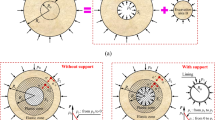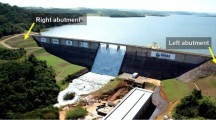Abstract
Underground excavation, such as tunneling and deep foundation pit, will no doubt induce the soil disturbance and have result in uneven settlements of adjacent buried pipelines which adversely affect and even damage the structures. In order to explicitly point out construction interaction mechanism and rapidly predict the structure mechanical behavior, a simplified displacement-controlled two-stage method and stress-controlled two-stage method are presented for determining the deformation behavior of pipeline structures caused by underground excavation in soil clays. According to tunneling project, the free soil deformation calculated by the displacement-controlled boundary element solution is used to estimate the soil disturbance effects of underground excavation. The oval-shaped ground deformation pattern is imposed to the tunnel opening to consider the nonuniform convergence characters. According to foundation pit project, the free soil stress based on the Mindlin solution is used to predict the soil disturbance effects of underground excavation. The situations that the excavation unloading center is not acting on the pipeline axis and that the excavation boundary and pipeline axis are formed with an arbitrary angle can fully be considered. Then, the free soil deformation and free soil stress are imposed onto existing pipelines to analyze the interaction mechanics between the disturbance soil and buried structures. The accuracy of proposed method is demonstrated with existing calculation results, centrifuge model tests, and site investigation data. In addition, the parametric analyses for the deformation influence factors of existing tunnel induced by foundation pit excavation, including the horizontal distance between the excavation boundary and tunnel axis, the tunnel buried depth, the tunnel bending stiffness, and the crossing angle between the excavation boundary and tunnel axis, are presented to demonstrate the performance of the proposed method. The results indicate that the proposed method can be used to estimate the mechanical behavior of buried pipelines considering disturbance effects of underground excavation with higher precision.























Similar content being viewed by others
References
Addenbrooke TI, Potts DM (2001) Twin tunnel interaction: surface and subsurface effects. Int J Geomech 1:249–271
Attewell PB, Yeates J, Selby AR (1986) Soil movements induced by tunneling and their effects on pipelines and structures. Blackie, London
Biot MA (1937) Bending of an infinite beam on an elastic foundation. J Appl Mech 59:1–7
Celestino TB, Gomes RAM, Bortolucci AA (2000) Errors in ground distortions due to settlement trough adjustment. Tunn Undergr Space Technol 15:97–100
Chang CT, Sun CW, Duann SW, Hwang RN (2001) Response of a Taipei Rapid Transit System (TRTS) tunnel to adjacent excavation. Tunn Undergr Space Technol 16:151–158
Chehade FH, Shahrour I (2008) Numerical analysis of the interaction between twin-tunnels: influence of the relative position and construction procedure. Tunn Undergr Space Technol 23:210–214
Chen Y (2005) Research on the heave displacement of tunnel induced by foundation pit. M.S. thesis, Tongji University, 2005. (in Chinese)
Dang HK, Meguid MA (2008) Application of a multilaminate model to simulate the undrained response of structured clay to shield tunnelling. Can Geotech J 45:14–28
Devriendt M, Doughty L, Morrison P, Pillai A (2010) Displacement of tunnels from a basement excavation in London. Geotech Eng 163:131–145
Dolezalova M (2001) Tunnel complex unloaded by a deep excavation. Comput Geotech 28:469–493
Gui MW, Chen SL (2013) Estimation of transverse ground surface settlement induced by DOT shield tunneling. Tunn Undergr Space Technol 33:119–130
He MC, Gong WL, Zhai HM, Zhang HP (2010) Physical modeling of deep ground excavation in geologically horizontal strata based on infrared thermography. Tunn Undergr Space Technol 25:366–376
Hsiung BCB (2009) A case study on the behaviour of a deep excavation in sand. Comput Geotech 36:665–675
Huang X, Schweiger HF, Huang HW (2013) Influence of deep excavations on nearby existing tunnels. Int J Geomech 13:170–180
Jacobsz SW (2002) The effects of tunnelling on piled foundations. Ph.D. thesis, University of Cambridge, Cambridge.
Japanese Civil Engineering Society (2001) Code for shield tunnel and explanation for tunneling. China Architecture & Building Press, Beijing (in Chinese)
Jia RH, Yang JS, Ma T, Liu SY (2009) Field monitoring and numerical analysis of shield tunneling considering existing tunnels. Chin J Geotech Eng 31:425–430 (in Chinese)
Juneja A, Hegde A, Lee FH, Yeo CH (2010) Centrifuge modelling of tunnel face reinforcement using forepoling. Tunn Undergr Space Technol 25:377–381
Kamata H, Mashimo H (2003) Centrifuge model test of tunnel face reinforcement by bolting. Tunn Undergr Space Technol 18:205–212
Khoiri M, Ou CY (2013) Evaluation of deformation parameter for deep excavation in sand through case histories. Comput Geotech 47:57–67
Klar A, Vorster TEB, Soga K, Mair RJ (2005) Soil-pipe interaction due to tunnelling: comparison between Winkler and elastic continuum solutions. Geotechnique 55:461–466
Kog YC (2010) Buried pipeline response to braced excavation movements. J Perform Constr Facil 24:235–241
Kung GTC, Juang CH, Hsiao ECL, Hashash YMA (2007) Simplified model for predicting wall deflection and ground surface settlement caused by braced excavation in clays. J Geotech Geoenviron 133:731–747
Kusakabe O, Kimura T, Ohta A, Takagi N (1985) Centrifuge model tests on the influence of axisymmetric excavation on buried pipes. Proceedings of 3rd International Conference on Ground Movements and Structures. Pentech, London
Lam SY, Elshafie MZEB, Haigh SK, Bolton MD (2012) Development of a new apparatus for modeling deep excavation related problems in geotechnical centrifuge. J Phys Model Geomech 12:24–38
Mindlin RD (1936) Force at a point in the interior of a semi-infinite solid. J Appl Phys 7:195–202
Ng CWW, Lu H, Peng SY (2013) Three-dimensional centrifuge modelling of the effects of twin tunnelling on an existing pile. Tunn Undergr Space Technol 35:189–199
Park KH (2004) Elastic solution for tunneling-induced ground movements in clays. Int J Geomech 4:310–318
Poulos HG, Davis EH (1980) Pile foundation analysis and design. Wiley, New York
Schuster M, Kung GTC, Juang CH, Hashash YMA (2009) Simplified model for evaluating damage potential of buildings adjacent to a braced excavation. J Geotech Environ Eng 135:1823–1835
Shanghai Municipal Standards (2010) Technical code for protection region of urban bridge and tunnels. Shanghai Urban Construction and Communications Commission, Administrative Decree of No.511 (in Chinese).
Sharma JS, Hefny AM, Zhao J, Chan CW (2001) Effect of large excavation on deformation of adjacent MRT tunnels. Tunn Undergr Space Technol 16:93–98
Son M, Cording EJ (2005) Estimation of building damage due to excavation-induced ground movements. J Geotech Geoenviron 131:162–177
Tang YG, Kung GTC (2010) Investigating the effect of soil models on deformations caused by braced excavations through an inverse-analysis technique. Comput Geotech 37:769–780
Vesic AB (1961) Bending of beams resting on isotropic elastic solids. J Eng Mech 87:35–53
Vorster TEB (2005) The effects of tunnelling on buried pipes. Ph.D. thesis, University of Cambridge, Cambridge.
Vorster TEB, Klar A, Soga K, Mair RJ (2005a) Estimating the effects of tunneling on existing pipelines. J Geotech Geoenviron 131:1399–1410
Vorster TEB, Mair RJ, Soga K, Klar A (2005b) Centrifuge modelling of the effects of tunnelling on buried pipelines: mechanisms observed. Proceedings of 5th International Symposium on Geotechnical Aspects of Underground Construction in Soft Ground, Amsterdam
Wang JH, Xu ZH, Wang WD (2010) Wall and ground movements due to deep excavations in Shanghai soft soils. J Geotech Geoenviron 136:985–994
Yamaguchi I, Yamazaki I, Kiritani Y (1998) Study of ground-tunnel interactions of four shield tunnels driven in close proximity, in relation to design and construction of parallel shield tunnels. Tunn Undergr Space Technol 13:289–304
Yoo C, Choi BC (2006) Excavation-induced buried pipeline failure—a case study. Solid State Phenom 110:23–30
Yoo C, Lee D (2008) deep excavation-induced ground surface movement characteristics—a numerical investigation. Comput Geotech 5:231–252
Acknowledgments
The authors acknowledge the financial support provided by the National Natural Science Foundation of China (No. 51008188 and No. 41172238), the Shanghai Natural Science Foundation (No. 15ZR1429400), the Open Project Program of State Key Laboratory of Geohazard Prevention and Geoenvironment Protection (No. SKLGP2015K015), and the Key Laboratory Fund for Mechanics on Disaster and Environment in Western China (Supported by Ministry of Education, No. 201202).
Author information
Authors and Affiliations
Corresponding author
Rights and permissions
About this article
Cite this article
Zhang, Z., Zhang, M. & Zhao, Q. A simplified analysis for deformation behavior of buried pipelines considering disturbance effects of underground excavation in soft clays. Arab J Geosci 8, 7771–7785 (2015). https://doi.org/10.1007/s12517-014-1773-4
Received:
Accepted:
Published:
Issue Date:
DOI: https://doi.org/10.1007/s12517-014-1773-4




